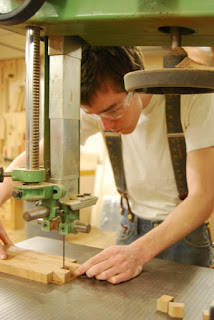
 I'm also very pleased with the color.
I'm also very pleased with the color.
A collection of musings from an simple living, agrarian desiring, craftsman living in the city of Philadelphia.

 I'm also very pleased with the color.
I'm also very pleased with the color.













 Yeah, I got oak. What's it to you? This board has some of the last pieces I need for the bed build. I did some color sampling today, I'll post tomorrow about that, glorious fun those W.D. Lockwood dyes.
Yeah, I got oak. What's it to you? This board has some of the last pieces I need for the bed build. I did some color sampling today, I'll post tomorrow about that, glorious fun those W.D. Lockwood dyes.

 If I was an "ar-tiste" I'd call this Transformation of a Riven Peg. I'm not, so this is the steps in making really strong pegs for drawboring. On an artsy note I really like how the Swiss Army Knife came out it's color and wear.
If I was an "ar-tiste" I'd call this Transformation of a Riven Peg. I'm not, so this is the steps in making really strong pegs for drawboring. On an artsy note I really like how the Swiss Army Knife came out it's color and wear.
 And the plate used to rive the pegstock. it's a piece of 5/16 mild steel with a 3/16" 1/4" 5/16" 3/8" and 7/16" diameter holes. It can't be hardened, because it's mild steel (insert drivel about chemistry) but that's no matter. It's attached to a chunk of D.Fir 4x4 with 5/8 holes bored under the cutting holes.
And the plate used to rive the pegstock. it's a piece of 5/16 mild steel with a 3/16" 1/4" 5/16" 3/8" and 7/16" diameter holes. It can't be hardened, because it's mild steel (insert drivel about chemistry) but that's no matter. It's attached to a chunk of D.Fir 4x4 with 5/8 holes bored under the cutting holes.  A mockup of the bed, I've still got work to do before I drawbore the short sides together, namely breaking the edges, smoothing and dying the parts.
A mockup of the bed, I've still got work to do before I drawbore the short sides together, namely breaking the edges, smoothing and dying the parts. All packed up and ready to take home. Good thing this project is almost over, I've been tiring of carrying one stick of lumber into and out of my apartment for the last few weekends. After moving the lumber for the workbench two or three more times I'll be ecstatic to work on smaller items like the molding planes and kumiko.
All packed up and ready to take home. Good thing this project is almost over, I've been tiring of carrying one stick of lumber into and out of my apartment for the last few weekends. After moving the lumber for the workbench two or three more times I'll be ecstatic to work on smaller items like the molding planes and kumiko.







 A closeup of the baseline pairing. Mahogany works very sweetly.
A closeup of the baseline pairing. Mahogany works very sweetly.



 Thanks Mario, for taking pictures again, interestingly enough he's got a bunch of experience shooting work as well as tools, it clearly shows.
Thanks Mario, for taking pictures again, interestingly enough he's got a bunch of experience shooting work as well as tools, it clearly shows.

 This is a shot of the tool corner of the room, which is also project lumber storage for three different pieces so far. Tomorrow I'm going to the LN event, I'll also be picking up bed oak, so add another project to the list.
This is a shot of the tool corner of the room, which is also project lumber storage for three different pieces so far. Tomorrow I'm going to the LN event, I'll also be picking up bed oak, so add another project to the list.



 One guy in the class (with whom I banter about the judicial use of electrons with) brought a lovely (well looks lovely) LN #212 scraper plane with him. He couldn't get it to work, after some fussing and lack of regard to "the instructions" Mario got it singing pretty sweetly on a piece of gnarly Sapelle.
One guy in the class (with whom I banter about the judicial use of electrons with) brought a lovely (well looks lovely) LN #212 scraper plane with him. He couldn't get it to work, after some fussing and lack of regard to "the instructions" Mario got it singing pretty sweetly on a piece of gnarly Sapelle. Drawing in the intersection lines for the spurs, the router leaves a 3/8" radius that will be carved into a sharp corner.
Drawing in the intersection lines for the spurs, the router leaves a 3/8" radius that will be carved into a sharp corner.



 Here we are after about 12 hours of work, not bad. The surface is pretty good, sanded to 320, though there is a spot where an errant glue drop or chip dented the surface. I might try steaming it out. I've seen that done with good success.
Here we are after about 12 hours of work, not bad. The surface is pretty good, sanded to 320, though there is a spot where an errant glue drop or chip dented the surface. I might try steaming it out. I've seen that done with good success.